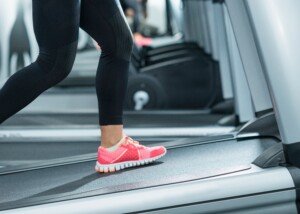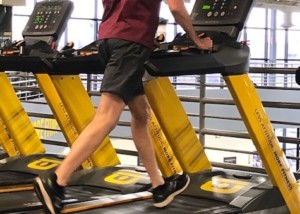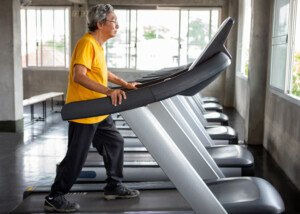
If you suffer from painful shin splints that keep interfering with your treadmill workout runs, you’ll want to consider gait training to reduce the pain.
Good news for treadmill runners suffering from stubborn and painful shin splints: A little outdoor gait training may help, according to 2024 research.
A randomized controlled trial found that four weeks of outdoor gait training, combined with home exercises often prescribed for shin splints, led to improved running biomechanics, even on a treadmill.
These improvements included decreasing the time runners’ feet were in contact with the ground or treadmill, a factor recently identified as a contributor to shin splints.
Based on the trial results, researchers, including UVA Health sports medicine expert David J. Hryvniak, DO, are recommending that clinicians include outdoor gait training in rehabilitation programs for patients with chronic shin splints.
Dr. Hryvniak says in the paper that gait-training cues can be a simple addition to the runner’s rehab program for improvement in running mechanics.
What are shin splints?
Affecting approximately 40% of all runners, shin splints typically begin as tenderness in the lower leg that subsides after exercising.
However, for regular runners, this pain can worsen and become persistent, potentially leading to stress fractures in severe cases.
Previous research has shown that short courses of outdoor gait training can significantly reduce shin-splint pain for outdoor runners, but experts were unsure if these benefits would transfer to treadmill running.
This uncertainty led an interdisciplinary team of researchers to launch a randomized trial to investigate if outdoor gait training would benefit treadmill users.
How the Study Was Conducted
The study enrolled 17 treadmill runners, 18 to 45, who ran at least three times a week and had experienced lower leg pain during or after running for at least a month.
The participants were randomly divided into two groups: one group received four weeks of outdoor gait training and performed commonly prescribed home strengthening exercises, while the other group only performed the home exercises.
During gait training, participants received “vibrotactile feedback” via special sensors in their shoes that detected when their feet were in contact with the ground for too long, helping them improve their stride and gait.
By the end of the study, both groups showed strength improvements in their legs, but the gait trainers also demonstrated improved running technique, or “favorable adjustments in running gait mechanics.”
These improvements were observed during both outdoor and treadmill runs, suggesting that outdoor gait training could be a valuable tool for treadmill users to run pain-free.
 Lorra Garrick has been covering medical, fitness and cybersecurity topics for many years, having written thousands of articles for print magazines and websites, including as a ghostwriter. She’s also a former ACE-certified personal trainer.
Lorra Garrick has been covering medical, fitness and cybersecurity topics for many years, having written thousands of articles for print magazines and websites, including as a ghostwriter. She’s also a former ACE-certified personal trainer.
.









































